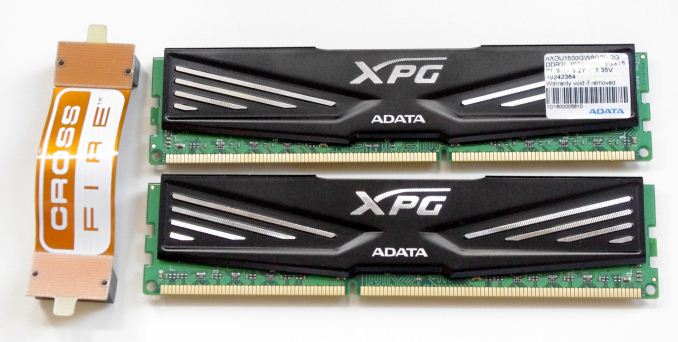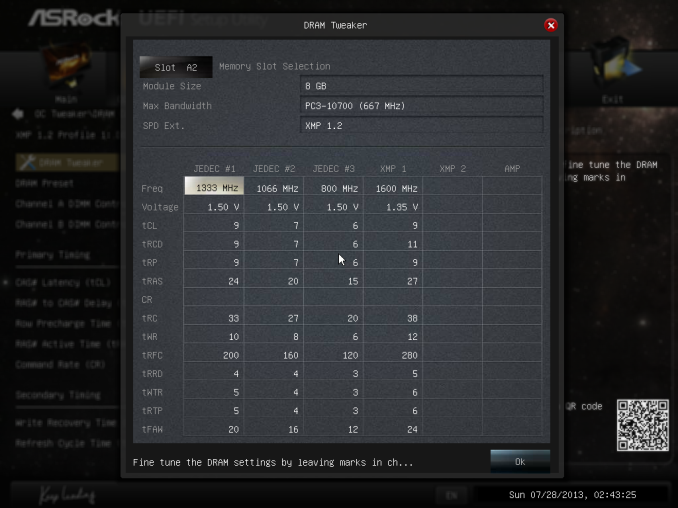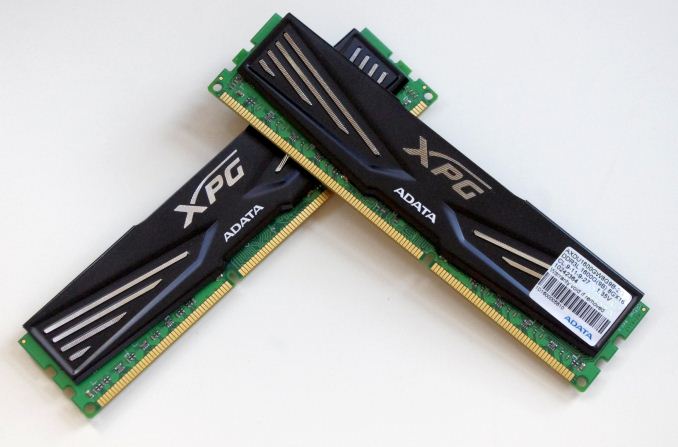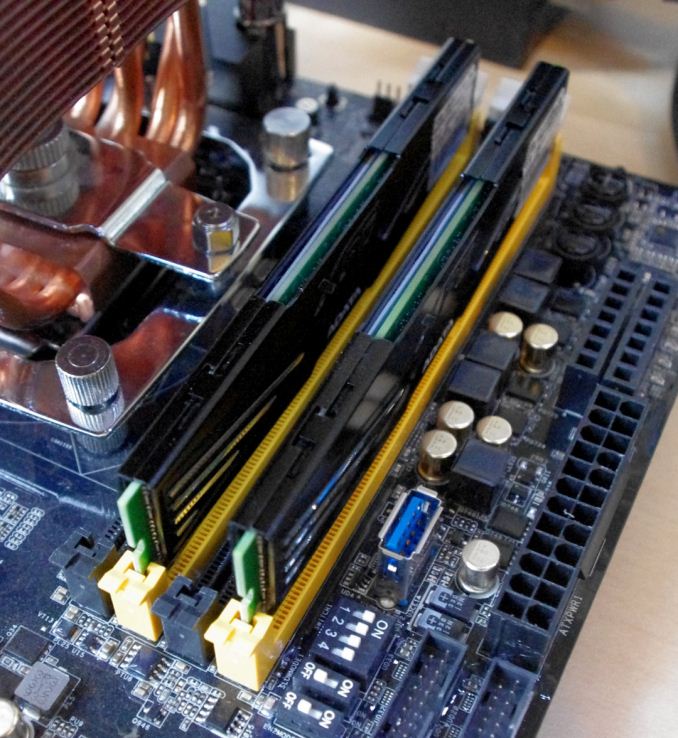ADATA XPG V1.0 Low Voltage Review: 2x8 GB at DDR3L-1600 9-11-9 1.35 V
by Ian Cutress on December 6, 2013 2:00 PM EST
For the next in our series of memory reviews on Haswell, we have another ADATA kit to test: this time a low voltage 2x8 GB kit featuring DDR3-1600 C9 timings. Being lower down the chain on a SKU list, the heatsinks are also smaller than the ones previously tested, and come in at £125. Previously in our big roundup of Haswell testing we suggested 1866 C9 being the minimum people should consider: would going 1600 C9 LV matter that much in results?
ADATA XPG V1.0 2x8GB DDR3L-1600 C9 1.35V Overview
ADATA’s line away from the more extreme (2400+) memory setups is aimed more conservative. If they were to use the same DRAM chips on board, those 2400 MHz C10 kits might hit lower voltages or lower CL numbers when we move down to 1600 MHz, so there is some potential in diversifying the product line of the same ICs as long as the market is there.
The AXDU1600GW8G9B-2G kit we are testing today is very unassuming next to those higher end modules – a simple small metallic based heatsink. When using a large air cooler like my TRUE Copper, they were easy enough to fit in unlike some of the larger modules.
The lower voltage element of memory intrigues me, most likely for the wrong reasons. The difference between 1.50 volt and 1.35 volt memory, in an overall system build, is not going to affect power draw in a measurable way. If you were building a 42U rack of servers, then yes, multiply out the DRAM modules you need across all the sockets and it can make sense if they are going to be active all the time. But at this juncture, even when a system draws sub 30W on idle and under 100W load, I cannot see a picture where moving from 1.50V to 1.35V makes a sizeable difference to a yearly electricity bill. Others may argue this point, but finding consistent data that converts to a decent power saving is hard to produce or come by. It would be more applicable to buy a lower TDP CPU (such as the i7-4765T, or E3-1230L V3) instead. That leaves a bit of e-peen for being low powered and green as positives, and the kit obviously has to stand on its own two feet when we push through the benchmarks.
In our big memory round-up for Z87 and Haswell, our cautionary tale was that slower MHz (under 1866) kits, rather than being restrictive, have a few holes in their performance on certain benchmarks, causing a 10-20% performance drop compared to the asymptotic limit hit when you go beyond 2133-2400 MHz. This ADATA 1600 C9 Low Voltage kit hits a couple of pot holes in that regard: WinRAR could be faster, as well as some of the minimum frame rates on a few games.
For Overclocking, our kit comes out of the bag with a Performance Index (PI) of 178: we pushed this to a PI of 200 (2000 10-12-10) with very little effort. This is a bit different from the PI of 240-260 which we see on the higher end kits.
Price wise, 2x8 GB 1600 C9 memory kits can be found for under $150 – the cheapest on Newegg today is actually a 1.35V kit for $129, followed by a 1.65V kit for $130. ADATA do not list this kit on Newegg, but in the UK the pricing is around £125 – if you take off our 20% tax and do the conversion, that lists it as nearer $170. ADATA’s XPG V2 and V1 normal voltage kits are at $165, with another at $150. This is still above some of their competition, and around $150 would make it a competitive choice for this segment.
Specifications
| ADATA | ADATA | Corsair | Patriot | ADATA | G.Skill | |
| Speed | 1600 | 2400 | 2400 | 2400 | 2800 | 3000 |
| ST | 9-11-9-27 | 11-13-13-35 | 10-12-12-31 | 10-12-12-31 | 12-14-14-36 | 12-14-14-35 |
|
Price (at review) |
£125 | $200 | - | $92 | $316 | $520 |
| XMP | Yes | Yes | Yes | Yes | Yes | Yes |
| Size | 2 x 8GB | 2 x 8GB | 2 x 8GB | 2 x 4GB | 2 x 8GB | 2 x 4GB |
|
Performance Index |
178 | 218 | 240 | 240 | 233 | 250 |
|
|
||||||
| MHz | 1600 | 2400 | 2400 | 2400 | 2800 | 3000 |
| Voltage | 1.35 V | 1.65 V | 1.65 V | 1.65 V | 1.65 V | 1.65 V |
| tCL | 9 | 11 | 10 | 10 | 12 | 12 |
| tRD | 11 | 13 | 12 | 12 | 14 | 14 |
| tRP | 9 | 13 | 12 | 12 | 14 | 14 |
| tRAS | 27 | 35 | 31 | 31 | 36 | 31 |
| tRC | 38 | 46 | 43 | 49 | ||
| tWR | 12 | 20 | 16 | 16 | ||
| tRRD | 280 | 315 | 301 | 391 | ||
| tRFC | 5 | 6 | 7 | 7 | ||
| tWTR | 6 | 10 | 10 | 12 | ||
| tRTP | 6 | 10 | 10 | 12 | ||
| tFAW | 24 | 33 | 26 | 29 | ||
| CR | - | 2 | 3 | 2 | ||
As you can imagine, this being our 1600 C9 kit for testing, the sub-timings are smaller than all the other kits we have tested. With a PI of 178 out of the box, there should hopefully be some room to grow.
Visual Inspection
Thankfully ADATA have avoided using annoying plastic packaging that can be a pain to get into – there is a simple tab on the back to help open their XPG line of memory. The packaging is simple enough, just a thin molded plastic to hold the memory in place. Out the memory modules come, barely taller than memory without heatsinks.
There is a slight z-height addition, but it should not affect many (if any) builds:



















35 Comments
View All Comments
azazel1024 - Friday, December 6, 2013 - link
Can't really argue most of the points.However, I find it mildly useful. I have a 2x4GB kit in my server, which is on nearly 24/7 (Task scheduler pulls it down to S3 from 1am back awake at 6am, because no one is ever awake to use it them).
I can run it at 1.2v since it is a G1610 Celeron, so only 1333mhz and its a G.Skill Sniper 1.25v DDR3 1600Mhz kit. Lowest I could go before was a single DIMM 4GB 1.5v module I could run at 1.4v before things got wonky.
Difference between the two DIMMs at 1.2v and 1.5v though is around 1.5W at idle on my kill-a-watt and around 2-3w when hitting the server with a heavy load. Not much, but it is a bit of green ePeen for me, and the thing does run close to 24x7. Sure, its still probably only $2 a year, but I am hoping to get several years out of the machine or at least the memory.
My desktop has 1.35V CAS9 kit in it, 4x4GB Mushkin DDR3 1600 kit. The advantage there is it'll run at 1866Mhz CAS10 and 1.38v stable. It was cheaper than any 2x8GB kits on the market at the time and actually slightly cheaper than any 4x4GB DDR3 1866 kits.
Case temp is a degree lower at 1.38v than at 1.5v and it also runs about 4w less under load.
It isn't much, but I pride myself on having low(ish) power setups, as well as running as quiet and cool as I can, plus especially the 16GB kit in my desktop, it was actually cheaper to get the LoVo memory and upclock it to 1866Mhz than it was to get a native 1866Mhz kit at the time.
The Von Matrices - Friday, December 6, 2013 - link
You make a very good point that I never though of before.S3 sleep still provides power to refresh the memory. If you are like me and never shut down your computer (instead using sleep) then your memory is consuming energy 24/7 no matter how infrequently the computer is powered on.
If you don't use your computer a lot but do use sleep, then the memory could account for a significant portion of the computer's overall energy consumption.
gamoniac - Sunday, December 8, 2013 - link
I have my server running 24x7, too, but the saving here is really not that significant. Basically, accidentally leaving a 60-watt light blub on over night would undo months of saving gained from this low-voltage RAM.ShieTar - Tuesday, December 10, 2013 - link
You're supposed to replace those bulbs by 10-watt LEDs as well ;-)It's not always about the current saving potential. Sure, 1W of 24/7 usage is only 2$ to 3$ of savings, depending on where you live, today. But with the increasing number of customers and constant or decreasing sources for electricity, it makes sense for us as a civilization to invest into power-saving technologies. So the low-voltage RAM is a fundamentally good Idea, and if the combined cost of Hardware and Electricity is comparable to normal-voltage modules, it makes plenty of sense to buy them. Even if you don't save enormous amounts of money right now, at least this module can now become the new baseline if everybody goes for it.
MrSpadge - Sunday, December 8, 2013 - link
During sleep the data in memory is refreshed, but I'm pretty sure there is no clock signal supplied, so it's not actually working. Hence power consumption should be significantly lower than running normally, I gues by about 1 to 2 orders of magnitude.JoannWDean - Saturday, December 14, 2013 - link
my buddy's aunt earned 14958 dollar past week. she been working on the laptop and got a 510900 dollar home. All she did was get blessed and put into action the information leaked on this site... http://cpl.pw/OKeIJoCygni - Friday, December 6, 2013 - link
What about heat? The real target market for these seems to be people (like me) interested in making true silent high performance PCs. Because its nearly 2014 and it's time to stop putting leaf blowers on the side of your case to play a video game.I would be interested in seeing what difference the voltage makes, and the comparison to the other kits.
BigLeagueJammer - Friday, December 6, 2013 - link
Here's an article with tests performed by Puget Systems:http://www.pugetsystems.com/labs/articles/Technolo...
The conclusion they found was that the lower voltage RAM made a 1-2 degree difference in CPU temperatures. That's not huge, but if you're striving for a really quiet build, it could help make it little bit more quiet.
MrSpadge - Sunday, December 8, 2013 - link
Playing a game you probably have a CPU+Mainboard+RAM drawing about 100 W, and a GPU drawing at least 100 W. Now subtract 1 to 2 W from low voltage RAM from this and you get less than 1% difference. This won't be audible even in direct comparisons.extide - Friday, December 6, 2013 - link
Regarding Low TDP CPU's.A lot of people don't seem to realize that Low TDP CPU's are basically the exact same thing as a regular TDP chip, except they don't turbo as much, hit as high freq/etc.
The point is a 84W i7 4770 will idle down just as low as a 35W i7-4765T, for example. It is only when the CPU is fully pegged that the lower TDP actually makes a difference.
For a normal desktop user, just browsing the internet/etc, this means that a 84W chip vs a 35W chip will make almost no difference, especially if they are the exact same configuration. (quadcore vs dualcore, same number of EU's in the graphics, etc) The CPU is idle/clocked down via speed step/etc most of the time anyways.
Back in the day, there used to be a bigger difference as the low-TDP chips had the same clocks and performance as the regular ones but ran on less volts. Back then, those low power chips were great. These days the low TDP ones typically run in similar voltage ranges, and whatnot but essentially their ability to reach into the higher ranges (voltage, clockspeed, etc) is significantly reduced. They are basically the exact same chips. There may be some mild binning involved, but if you really want a good-binned CPU for low power then you will probably need to get a mobile/laptop chip.
So basically unless you are running F@H or something, a T or S series CPU is really pointless. Unless you are an OEM, and NEED to strictly adhere to some thermal limit due to a small cooler or something, I see almost zero reason to go for a T/S series CPU, ES{ECIALLY when they typically cost more!
I see lots of people using T/S series cpu's in things like PC-based routers. That is a prime example of a place where it is pointless to do so, because the cpu will be idle 99% of the time anyways, and a normal TDP chip can clock/volt down just as much as a low tdp chip.
Just some food for thought. Sorry, it is a tiny bit off-topic with regards to the actual article, but you do mention power savings and low TDP chips in there.